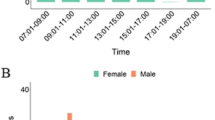Summary
Studies were conducted to determine whetherTribolium castaneum exposed to the microsporidan,Nosema whitei, produced fewer offspring than those not exposed to the parasite. When adultT. castaneum were exposed to the parasite after copulation, significant differences occurred between the number of larvae emerging from eggs laid by control (not exposed) and infected (exposed) beetles during the second and fourth weeks. However, no significant differences were observed when the beetles were exposed to the parasite prior to mating. On the other hand, whenT. castaneum were exposed toN. whitei as larvae, a marked decrease in the number of larvae emerging occurred.
Similar content being viewed by others
References
Anthony, D.W., Savage, K.E., Weidhaas, D.E.: Nosematosis: Its effect onAnopheles albimanus Wiedemann, and a population model of its relation to malaria transmission. Proc. Helminthol. Soc. Wash.39, 428–433 (1972)
George, C.: The effects of malnutrition on growth and mortality of the red rust flour beetleTribolium castaneum (Coleoptera: Tenebrionidae) parasitized byNosema whitei (Microsporidia: Nosematidae). J. Invertebr. Pathol.18, 383–388 (1971)
Milner, R.J.:Nosema whitei, a microsporidan pathogen of some species ofTribolium. III. Effect onT. castaneum. J. Invertebr. Pathol.19, 248–255 (1972a)
Milner, R.J.:Nosema whitei Weiser, a microsporidan pathogen of some species ofTribolium. I. Morphology, life cycle, and generation time. J. Invertebr. Pathol.19, 231–238 (1972b)
Milner, R.J.:Nosema whitei, a microsporidan pathogen of some species ofTribolium. IV. The effect of temperature, humidity, and larval age on pathogenicity forT. castaneum. Entomophaga18, 305–315 (1973)
Shinholster, D.L.: The effects of X-irradiation and chemotherapy on the host-parasite relationships betweenTribolium castaneum (Herbst) and two protozoan parasites,Nosema whitei Weiser andAdelina tribolii Hesse. Ph.D. Thesis, Cornell University, Ithaca, NY (1974)
Smirnoff, W.A.:Thelohania pristiphorae sp. n., a microsporidian parasite of the larch sawflyPristiphora erichsonii (Hymenoptera: Tenthredinidae) J. Invertebr. Pathol.8, 360–364 (1966)
Veber, J., Jasic, J.: Microsporidia as a factor in reducing fecundity in insects. J. Insect Pathol.3, 103–111 (1961)
Zimmack, H.L., Brindley, T.A.: The effect of the protozoan parasite,Perezia pyrausta in the European corn borer. J. Econ. Entomol.50, 637–640 (1956)
Author information
Authors and Affiliations
Rights and permissions
About this article
Cite this article
Armstrong, E. Nosema whitei: Effects on the emergence ofTribolium castaneum . Z. Parasitenkd. 58, 35–39 (1978). https://doi.org/10.1007/BF00930789
Received:
Issue Date:
DOI: https://doi.org/10.1007/BF00930789




